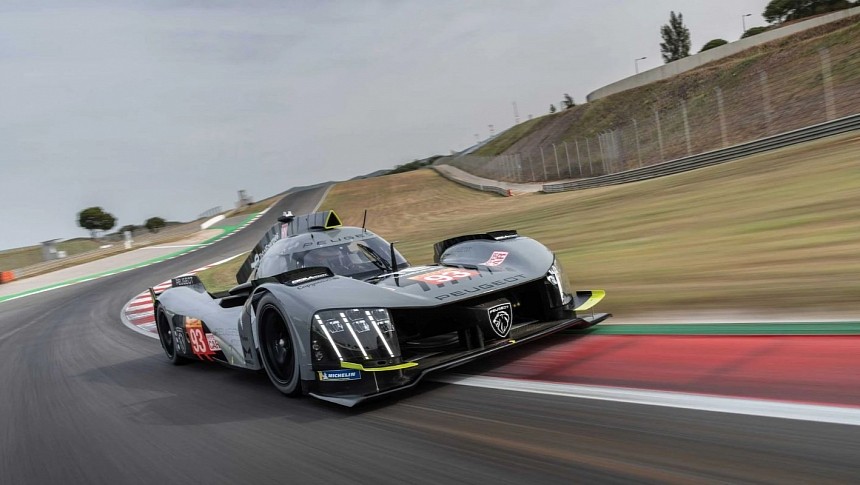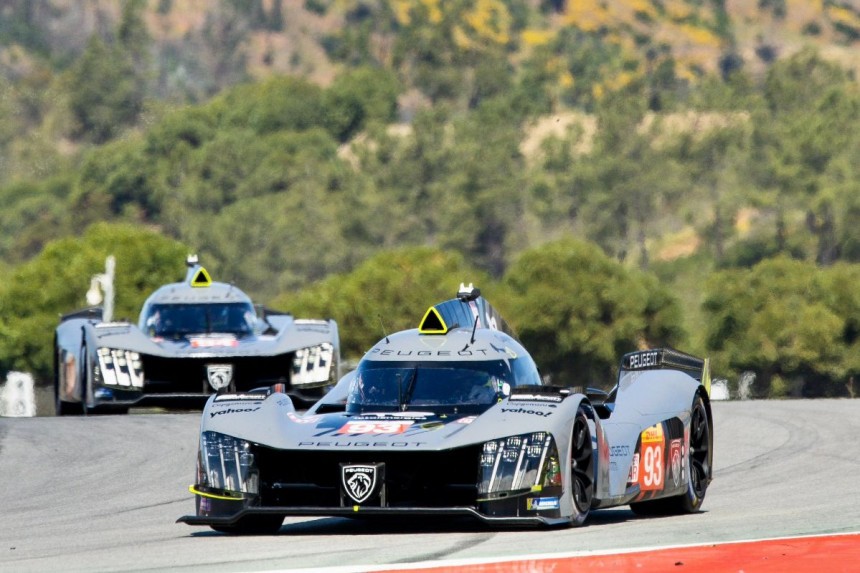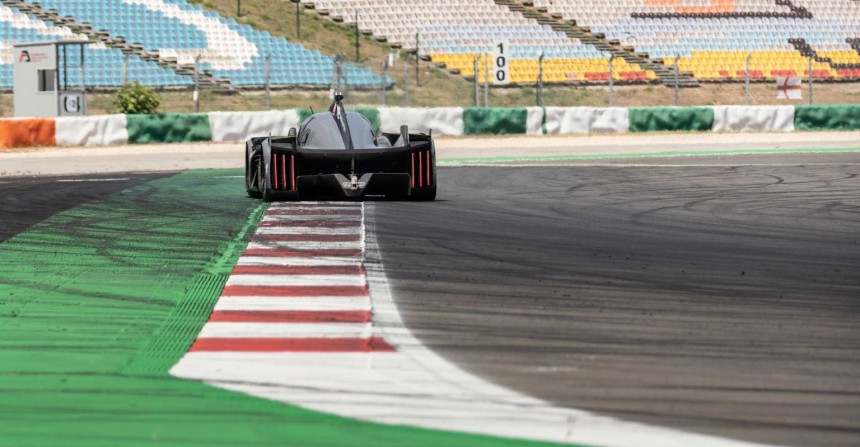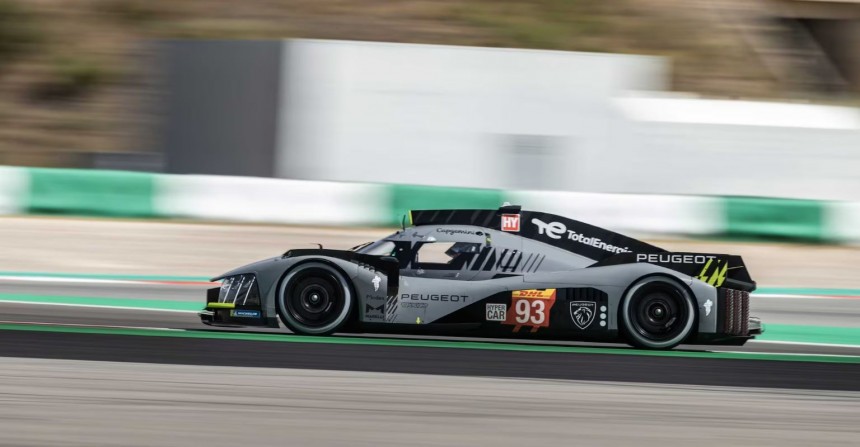Peugeot's new 9X8 Le Mans Hypercar is encountering some early struggles, but this is not uncharted territory for the French automaker.
This marks the third time Peugeot has returned to top-tier sportscar racing, following the 905 Group C and the 908 LMP1 projects that brought France three victories at the iconic Le Mans 24 Hours. However, history shows that neither of these models won on their debut attempt. Despite this, the 9X8 has an opportunity to make history and secure a fourth victory for Peugeot, but it would require an upset in the 2023 WEC season.
While there are similarities between the 905 and the 9X8, the latter is a truly unique machine. The original V10-powered 905 had to undergo extensive redesigns before it became a successful racer. Today's 9X8 is also the product of inputs from outside the racing department, resulting in its bold and distinctive design, featuring an aggressive front and a rear without a traditional wing.
The LMH regulations allow for race cars to incorporate the brand's design cues, which was a significant factor in Peugeot's decision to return to endurance racing. This decision came almost eight years after the automaker scrapped the HYBrid4 hybrid 908 just before the start of the 2012 season, which seemed like the end of Peugeot's sportscar racing dreams. However, the LMH rules have allowed Peugeot to return to the track in a way that embraces its unique style and engineering prowess.
In 1981, Jean Todt established the Peugeot Sport department, which produced the first prototype of a new Peugeot supercar. This vehicle's design was based on the 1988 Paris Motor Show concept car, the Oxia. The aerodynamics of the 905, which raced in the 1990 World Sports-Prototype Championship, were not entirely innovative, according to Philippe Alliot, a frequent Peugeot driver. Instead, he suggests that the car's shape was primarily a product of styling. Tim Wright, a British engineer brought in by former Formula 1 champion Keke Rosberg to help refine the car, was surprised to find that the design team had a lot of creative freedom. Despite its stunning appearance, he recalls that the car was "so hopeless."
Oddly enough, the car's first victory revealed just how inadequate it was. In April 1991, Peugeot drivers Philippe Alliot and Mauro Baldi won the opening round of the newly renamed Sportscar World Championship at Suzuka, benefiting from some lucky breaks. The 905 was the first genuine 3.5-liter Group C car, with no established benchmarks, when it debuted at the Montreal and Mexico City rounds of the WSPC in 1990.
Peugeot was faced with a daunting challenge when Jaguar's XJR-14 entered the fray, qualifying 2.5 seconds ahead of the best Peugeot. A crisis meeting at Peugeot Sport's headquarters in Velizy was convened, and a significant development program focusing on aerodynamics was launched. In three months, the stubborn 905 was transformed into a competitive machine, earning a 1-2 victory on home ground at Magny-Cours with Rosberg and Dalmas leading the charge. The 905 went on to notch up five wins out of six races in 1992, including a back-to-back triumph at Le Mans. Despite discontinuing the SWC and Toyota's new TS010, the 905 emerged victorious again in 1993, finishing 1-2-3. The drivers who raced the 905 fondly recall it as a "virile racing car."
Thirty years ago, Peugeot's 905 race car was a prime example of development trumping design. Fast forward to today, and the 2.6-liter twin-turbo V6 9X8 faces different challenges in the Hypercar class. The stringent rules limit performance modifications over a car's lifespan, freezing the technical specifications upon homologation. The in-house Peugeot Sport team is tasked with maximizing the 9X8's unconventional design that has yet to make a mark in six WEC outings. So far, the French cars have been at the bottom of the manufacturer rankings in the pre-Le Mans rounds this year.
It may be tempting to believe that the Peugeot bosses made incorrect choices when conceptualizing the 9X8, but the reality is more complex. Olivier Jansonnie, the technical director of the LMH program at Satory, insists that the options were appropriate at the time. The LMH rules have undergone multiple changes since Peugeot announced its return to sportscar racing, including a decrease in minimum weight and an increase in the deployment speed for the front-axle hybrid system. When the 9X8 was in the design phase, the size of the wheels and tires mandated by the hybrid LMH allowed for a wingless concept. However, that has since changed.
According to Jansonnie, the LMH rules initially suggested that manufacturers had two choices on tire size: 31cm all around or 29cm front and 34cm rear. Peugeot explored the possibility of running the 29/34 option, but the FIA and the Automobile Club de l'Ouest informed them that the 31/31 option was mandatory for four-wheel-drive hybrids like the 9X8. The 29/34 option was reserved for two-wheel-drive machines, non-hybrid LMHs, and LMDhs.
The convergence process has since changed the rules, requiring all new cars to run 29/34, except for those homologated and raced prior to this season. Although Toyota switched to 29/34 with its GR010 HYBRID, Peugeot was unable to follow suit due to its unusual concept.
The future remains uncertain as to whether Peugeot can transform the 9X8 into a victorious contender or if they'll need to go back to the drawing board. The Balance of Performance might lend a helping hand, but it's still unclear. Under the current rules, manufacturers have the opportunity to develop an entirely new car. Peugeot's previous attempts with the 908 turbodiesels, both the original V12 and the subsequent V8 iteration known as the 90X, raced in the 24 Hours of Le Mans on five occasions, managing only a single triumph. History hasn't been kind to the program, overshadowed by Audi's dominance in the crucial race.
Nevertheless, the arrival of the 908 in 2007 marked the beginning of an epic rivalry in the realm of sports cars. Their respective turbodiesel machines battled fiercely for glory worldwide, resulting in two unforgettable editions of the 24 Hours of Le Mans in 2008 and 2011. Although Peugeot was defeated on both occasions, their victory with a 1-2 finish in 2009 secured the brand's third triumph at Le Mans.
While a trio of victories at the 24 Hours of Le Mans would have been a remarkable feat, Peugeot's track record outside of Circuit de la Sarthe is astonishing. They often outshone Audi, amassing an impressive tally of 25 wins from 35 starts. Notably, they triumphed in the Sebring 12 Hours and the Petit Le Mans 1000-mile event at Road Atlanta, the other prestigious endurance classics in which the 908s were eligible to compete. Along the way, Peugeot claimed championship titles in the Le Mans Series and the Intercontinental Le Mans Cup, the precursor to the WEC.
However, it's worth noting that the 908 didn't secure a Le Mans victory until its third attempt. The question now lingers: Will the 9X8 be granted the same opportunity?
While there are similarities between the 905 and the 9X8, the latter is a truly unique machine. The original V10-powered 905 had to undergo extensive redesigns before it became a successful racer. Today's 9X8 is also the product of inputs from outside the racing department, resulting in its bold and distinctive design, featuring an aggressive front and a rear without a traditional wing.
The LMH regulations allow for race cars to incorporate the brand's design cues, which was a significant factor in Peugeot's decision to return to endurance racing. This decision came almost eight years after the automaker scrapped the HYBrid4 hybrid 908 just before the start of the 2012 season, which seemed like the end of Peugeot's sportscar racing dreams. However, the LMH rules have allowed Peugeot to return to the track in a way that embraces its unique style and engineering prowess.
In 1981, Jean Todt established the Peugeot Sport department, which produced the first prototype of a new Peugeot supercar. This vehicle's design was based on the 1988 Paris Motor Show concept car, the Oxia. The aerodynamics of the 905, which raced in the 1990 World Sports-Prototype Championship, were not entirely innovative, according to Philippe Alliot, a frequent Peugeot driver. Instead, he suggests that the car's shape was primarily a product of styling. Tim Wright, a British engineer brought in by former Formula 1 champion Keke Rosberg to help refine the car, was surprised to find that the design team had a lot of creative freedom. Despite its stunning appearance, he recalls that the car was "so hopeless."
Peugeot was faced with a daunting challenge when Jaguar's XJR-14 entered the fray, qualifying 2.5 seconds ahead of the best Peugeot. A crisis meeting at Peugeot Sport's headquarters in Velizy was convened, and a significant development program focusing on aerodynamics was launched. In three months, the stubborn 905 was transformed into a competitive machine, earning a 1-2 victory on home ground at Magny-Cours with Rosberg and Dalmas leading the charge. The 905 went on to notch up five wins out of six races in 1992, including a back-to-back triumph at Le Mans. Despite discontinuing the SWC and Toyota's new TS010, the 905 emerged victorious again in 1993, finishing 1-2-3. The drivers who raced the 905 fondly recall it as a "virile racing car."
Thirty years ago, Peugeot's 905 race car was a prime example of development trumping design. Fast forward to today, and the 2.6-liter twin-turbo V6 9X8 faces different challenges in the Hypercar class. The stringent rules limit performance modifications over a car's lifespan, freezing the technical specifications upon homologation. The in-house Peugeot Sport team is tasked with maximizing the 9X8's unconventional design that has yet to make a mark in six WEC outings. So far, the French cars have been at the bottom of the manufacturer rankings in the pre-Le Mans rounds this year.
It may be tempting to believe that the Peugeot bosses made incorrect choices when conceptualizing the 9X8, but the reality is more complex. Olivier Jansonnie, the technical director of the LMH program at Satory, insists that the options were appropriate at the time. The LMH rules have undergone multiple changes since Peugeot announced its return to sportscar racing, including a decrease in minimum weight and an increase in the deployment speed for the front-axle hybrid system. When the 9X8 was in the design phase, the size of the wheels and tires mandated by the hybrid LMH allowed for a wingless concept. However, that has since changed.
The convergence process has since changed the rules, requiring all new cars to run 29/34, except for those homologated and raced prior to this season. Although Toyota switched to 29/34 with its GR010 HYBRID, Peugeot was unable to follow suit due to its unusual concept.
The future remains uncertain as to whether Peugeot can transform the 9X8 into a victorious contender or if they'll need to go back to the drawing board. The Balance of Performance might lend a helping hand, but it's still unclear. Under the current rules, manufacturers have the opportunity to develop an entirely new car. Peugeot's previous attempts with the 908 turbodiesels, both the original V12 and the subsequent V8 iteration known as the 90X, raced in the 24 Hours of Le Mans on five occasions, managing only a single triumph. History hasn't been kind to the program, overshadowed by Audi's dominance in the crucial race.
Nevertheless, the arrival of the 908 in 2007 marked the beginning of an epic rivalry in the realm of sports cars. Their respective turbodiesel machines battled fiercely for glory worldwide, resulting in two unforgettable editions of the 24 Hours of Le Mans in 2008 and 2011. Although Peugeot was defeated on both occasions, their victory with a 1-2 finish in 2009 secured the brand's third triumph at Le Mans.
However, it's worth noting that the 908 didn't secure a Le Mans victory until its third attempt. The question now lingers: Will the 9X8 be granted the same opportunity?


















